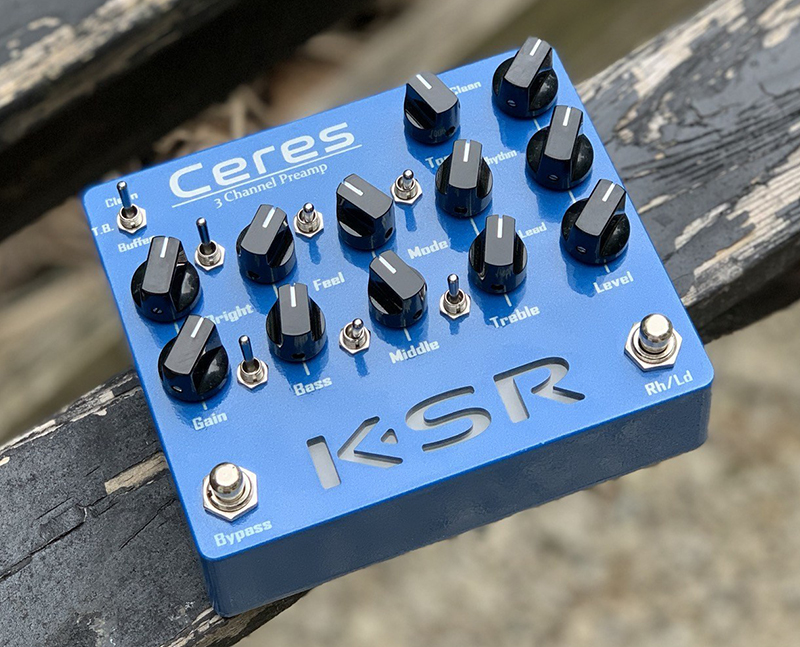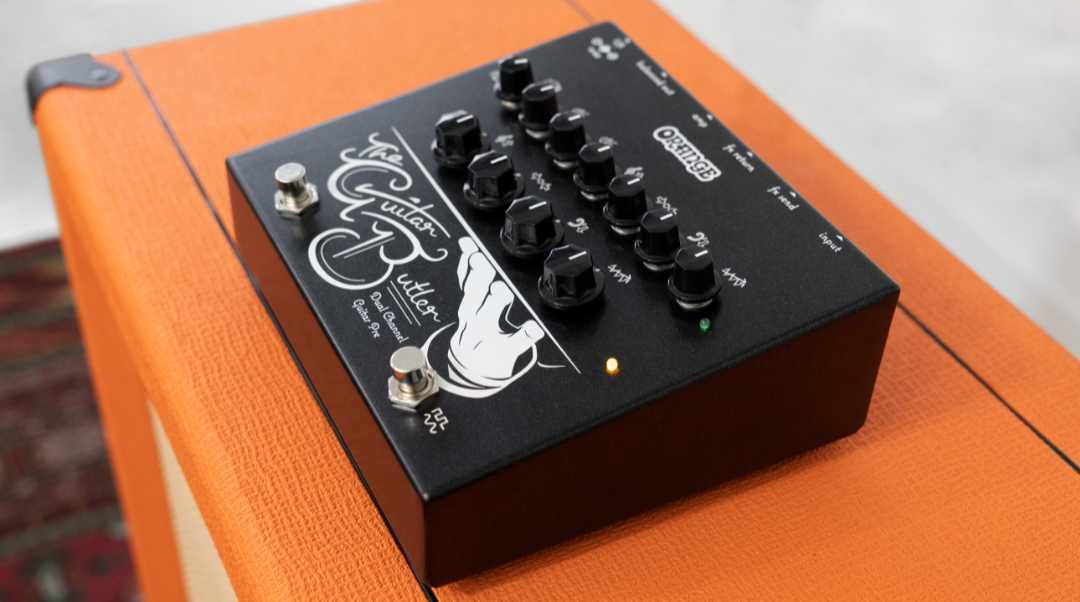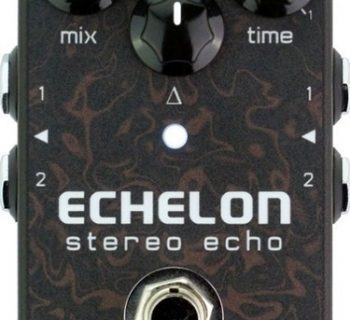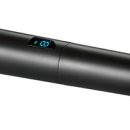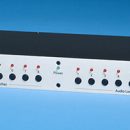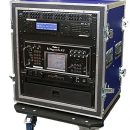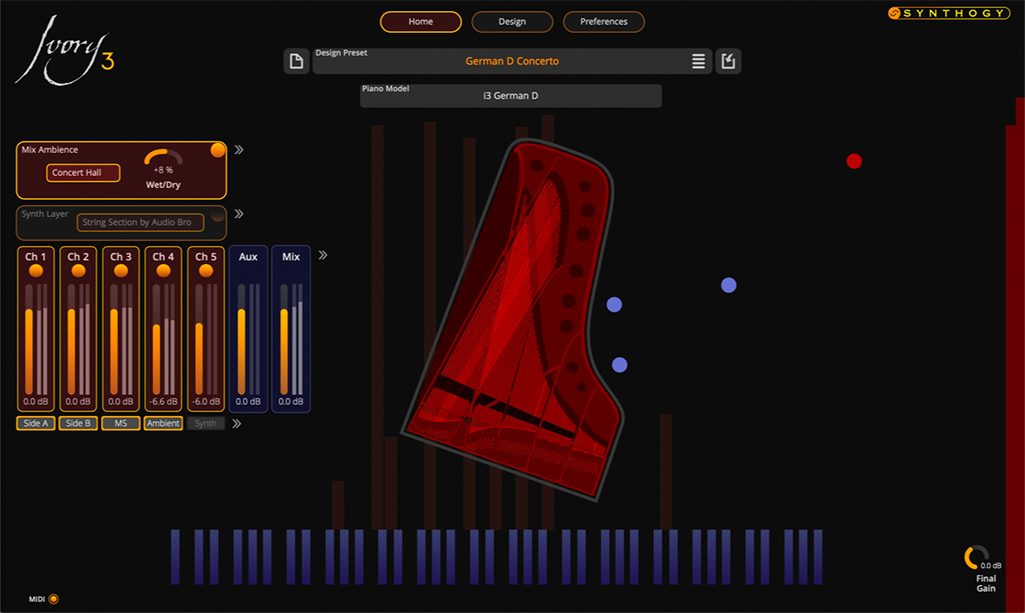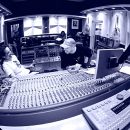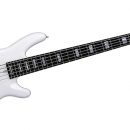With so many ways to get a great guitar sound in 2019, a serious guitar player can go crazy over the multitude of avenues he or she can utilize in amplifying their guitar signals. Between “real” amps, modeled amps, profiled amps, and studio plug-ins, an often overlooked and seemingly dated signal chain is the separate pre and power amp configuration. Yesteryear’s preamps typically consisted of one rack space (or more) legendary gear such as the ADA MP1, Marshall JMP1, Mesa Boogie Triaxis, and many others. These were once mainstays on the guitar tone landscape and seem to have fallen out of favor in place of tube combos, half stacks or digital modeling rigs.
But guitar preamps in pedal form have made a bit of a resurgence. Although the market seems to offer bass preamps vs. guitar preamps at a ratio of about 10:1, there are still a ton of options for the guitarist who wants their pedal-based analog tone generated from the floor and amplified somewhere down the signal chain. KSR enters the arena with not a bang, but a full-on bomb drop, with their new three-channel marvel, the Ceres preamp pedal. Cincinnati-based amp guru Kyle Rhodes is no stranger to great tone, and his attempt at capturing some of the magic of his widely respected boutique amp line in a compact form comes through beautifully. There are many ways to use this preamp pedal, all with great results.
Features
The made-in-USA Ceres 3 Channel Preamp is true to its name. Each of its three channels are fully independent in their sound shaping. Having a fair footprint of 5.75”x 4.75”, it takes up roughly the same space as a BOSS Twin pedal on our board.
A quarter-inch mono input and output are placed conveniently on the rear of the pedal. A 9V center negative, 6mm barrel power connector jack is placed between the audio jacks. Interestingly, the pedal will not short if it inadvertently receives over 9.7V. The unit will simply shut down to prevent damage, a useful feature we’d love to see in more manufacturers pedals.
A very nifty feature which comes in handy for the plug and play crowd is a printed schematic on the bottom of the pedal for key functions, most relating to the toggles on the pedal. Didn’t read the manual? Some of what you need to know is right there for you.
Before getting to the good stuff, we’d like to talk about the bypass mode toggle. It appears on the upper left corner of the pedal and is a three-way toggle. The center position is true bypass, taking your signal from input to output and not touching it. The down position is buffered bypass, which helps get the signal as intended to the next pedal in line and possibly to a clean amp. The top position is clean bypass, which is the only way to bring the clean channel of this pedal into play. The clean channel is designed to be a pristine clean. The channel consists of two knobs, offering only tone and level. If you desire more tone shaping than this, you’ll need further processing down stream.
Moving on, we find in the center and bottom row of switches and knobs the two distortion channels. They appear identical although sound slightly different, dedicated to crunch and lead duties, respectively. The gain and EQ controls are self explanatory. Staggered in between the two rows of knobs are a two-way Bright toggle along with Feel and Mode three-way toggles. Bright is simple, on or off. Feel gives us Fat, Tight or Thick options. Mode offers Ares Crunch, Artemis Red, or Colossus Red inspired channels from KSR’s boutique amp line. Being able to set these independently per channel is a fantastic feature and could easily not have been the case in order to save cost.
The two buttons appearing in the bottom corners of the pedal are the Bypass and Rhythm/Lead toggle buttons. A pretty awesome feature is the large KSR logo glows either blue for rhythm or white for lead. This is both functional and aesthetically pleasing.
Lastly, just to show KSR thought of everything, we must mention the external control TRS jack (1/8”) on the back of the pedal. This enables you to use a looper to assign channel switching.
Usability
The metal housing and many toggles, knobs, and buttons feels solid and well built, and hooking up the pedal is straightforward. There is no battery option so we used one of many pedalboard power supplies we had on hand. We plugged the pedal in and it lit right up. Connecting inputs and outputs, we had sound instantly. Not reading the manual was to our detriment, however. We got a lot more out of the pedal tonally after we understood what we were doing. Yes, the pedal is plug and play if that’s how you choose to operate.
Having three separate level controls, the channels were simple to balance and we were able to volume match in no time. This pedal provides a true, all-analog signal path. MIDI channel switching might have been a nice feature, but remote channel switching via the TRS jack worked just fine. We really had no issues at all making the pedal work, and there were no issues dialing up useable—no, make that great—sounds in no time.
Four small rubber feet are included in the box should you decide to use this pedal on the floor or on a studio desktop.
Sound
This is where we had the most fun, and were floored by just how great this preamp sounds. As suggested in the manual, there are a host of ways to connect the pedal and achieve great results. Straight into the front of an amp is notthe best way to use it!
We plugged in our DiMarzio-loaded Ibanez S Prestige guitar and ran the output into the front of our Fractal AxeFX III. A beast in its own rite, we set the fractal to solely function as a cabinet simulator and did not even load up an amp sim on the tested patch. Calling up our favorite 4x12 IR, we dimed the gain on the lead channel and went for broke! The results were a touch bright for our ears, and the treble knob dialed back to around 3:00 was were we loved it. Yes, we absolutely fell in love with the tone. It was beautifully organic, massively aggressive, and a bit compressed, which was great for leads. It was hard to believe there wasn’t a single tube anywhere in our signal path! Interestingly, we re-tracked guitars on a test session we were working with and compared it to the AxeFX III amp simulation: let’s just say “different flavors of really fantastic sounds.” There was no clear winner as far as tone went. Yes, using the same IR they sounded different, but high quality and great tone came to mind when hearing playback of both takes.
Audio demo by Bruce Sokolovic... with no amp!
We then plugged the Ceres pedal into the effects return of our Mezzabarba Skill 30 combo, which completely bypassed the preamp section and gave us the sound of the Ceres into a tube power amp. This was also a good, useable tone, a bit tighter than Mezzabarba amp’s natural tone, and the gain was a little more reserved, though fairly placed in the modern, high gain category. The pedal not only serves as a great centerpiece for a rig but also serves as a great backup if your tube amp were to fail during a gig. Alternately, you could rely on various venues’ backline amps as long as those had FX loops and just get your massive KSR tone without having to lug a big tube amp along.
KSR Ceres preamp pedal into a Peavey Classic Series 60 watt tube power amp. Emperor 4x12 with Greenback type speakers. SM57 straight into iPhone via iRig Pre HD. Video courtesy KSR Amplification.
Documentation and Product Support
Included with the pedal is a brief, four-page manual. The manual is quite thorough, and describes intended uses and warns of some pitfalls should you go too far off the beaten path with settings. Many video demos appear on the product page, too.
Kyle Rhodes himself is pretty accessible, and having little to no idea who this reviewer was, chatted with me online as I was preparing this review. Boutique guitar and amp companies often offer this personal touch, and it is well appreciated.
A three-year warranty is included with every pedal, which shatters most standard warranties.
Price
The KSR Ceres 3 Channel Preamp sells direct for $400.00 from the KSR website. Tone being subjective, this is definitely among the best and most versatile tone generating pedals we have come across, and we come across a lot of pedals!
At $400, it is firmly in the boutique realm and this price point is not to be taken lightly, but considering an actual KSR amplifier will cost you at least $2,000, this pedal provides a comparable value, and yes, it delivers comparable tone.
Contact Information
KSR Amplification
www.ksramps.com


